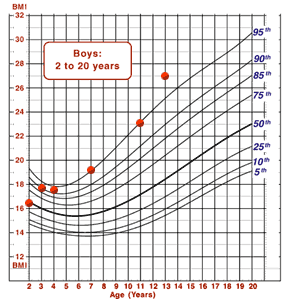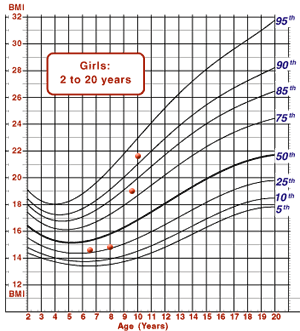 |
 |
 |
 |
 |
 |
Childhood obesity is not a harmless condition. It can have both physical and psychological consequences. Obese children are at higher risk for high blood pressure and high cholesterol, which are the main factors of coronary artery disease and stroke. Also, type II diabetes is a risk of obesity because the pancreas no longer functions to supply the body with the appropriate amount of insulin to maintain normal blood sugar levels in order to prevent hypo or hyperglycemia. Other concerns are orthopedic problems, social rejection, and low self-esteem.
Childhood is a critical period for shaping the dietary and life-style behaviors that can have implications for adult heart disease risk. Parental recognition and acceptance that their child is over-weight is crucial if interventions are to be successful. Many parents of overweight children fail to recognize that their child is over-weight.
One of the best measures of
determining whether or not a child is overweight is the Body Mass
Index. Overweight and obesity are a result of increased calories
and decreased physical activity. Overweight is defined by age
and gender-specific over the 95th percentile of body mass index
(BMI). The BMI can be found by dividing the child's weight in
kilograms by his/her height in meters squared. It is easier to
divide the weight in pounds by the height in inches squared (height
x height), and multiply that answer by 703. The BMI is then plotted
on a growth chart (shown above). Or the BMI can be calculated
for you by going to the webMD link and entering in the height
and weight. http://my.webmd.com/content/tools/1/calc_bmi.htm
The chart for boys can be found
on the web at
http://www.cdc.gov/nchs/data/nhanes/growthcharts/set1clinical/cj41l023.pdf
and the chart for girls is at
http://www.cdc.gov/nchs/data/nhanes/growthcharts/set1clinical/cj41l024.pdf
You can also request a chart from me. A child with a BMI over the 85th percentile is considered overweight, and a child over the 95th percentile is considered obese.
Contrary to common thought, controlling feeding practices most likely contributes to, rather than prevents, childhood obesity and eating problems. It seems that parental control interferes with child's ability to learn and respond to the internal cues of hunger and satisfaction that teach self-regulation. Some experts suggest putting food in front of the child for 20-30 minutes and then removing anything that is not eaten to help a child learn to regulate his or her own eating practices. Children will not starve themselves. They'll eat when they're hungry.
Do not keep high sugar or fat snacks in the house, but have healthy snacks available. Grapes and cut up bananas can be frozen and used for snacks. They can also be added to non-fat milk and blended to make a tasty "milkshake." One parent kicked the "popcorn at the movies" habit, by allowing her child to sneak an apple into the theater. The thrill of sneaking something in outweighed the loss of the popcorn.
Regular physical exams are important for all children, and especially for overweight or obese children. Early signs of heart disease can be found in young children, and those children need to be monitored and treated to prevent complications in adulthood. Obese children should have a physical exam before starting an exercise program.
Increasing the amount of exercise a child gets is also important in controlling weight. TV, computer and video games could be limited to two hours a day. Increasing the amount of exercise is most successful if the whole family participates. If you are unable to exercise yourself, try enrolling your child in a sports program and then go and cheer him/her on. You could enroll your child in swimming lessons. It's non-competitive, and frankly, "fat floats," so the obese child may be more successful than leaner peers. Allow your child to start any exercise slowly. Walking a block may be all an obese child can comfortably do, but if he/she does it consistently, the benefits will be noticed, and the child will be more willing to continue.
One of the most important things you can do is let your child know how much you care about him or her, and how much you want to see him or her happy and healthy. It is essential to educate your child that a healthy lifestyle is for life.
Disclaimer: This information is not intended be a substitute for professional medical advice. It is provided for educational purposes only. You assume full responsibility for how you choose to use this information.